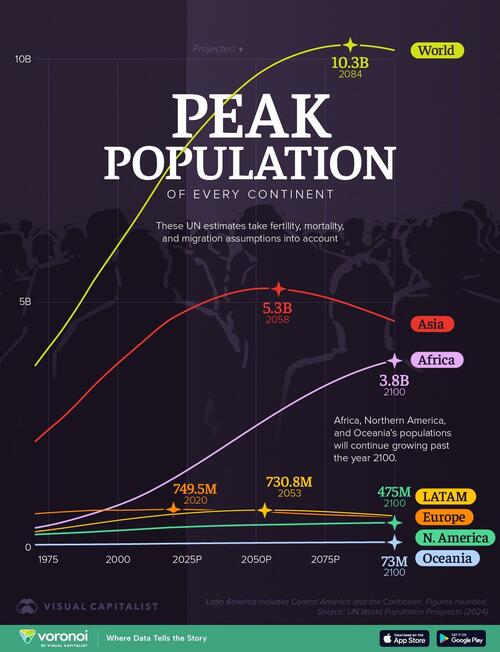Here's When Every Continent's Population Will Peak This Century
Here's When Every Continent's Population Will Peak This Century
After 350 straight years of global population growth - including a 4x surge from 2 billion in the year 1920 - this trend is finally set to reverse.
Earth’s population is expected to peak in 2084 at 10.3 billion after which it will begin tapering off.
This graphic, via Visual Capitalist's Pallavi Rao, explores every continent’s population from 1975 to 2100, with estimates used from 2025 onward.
Data comes from the UN’s World Population Prospects (2024).
Peak Population Year For Every Continent and Region
While global peak population is still around 60 years away, some regions will hit their peak a lot sooner.
Europe, for example, already peaked in 2020 at 750 million people.
Note: All figures are estimates.
Meanwhile, Asia and Latin America will hit their peaks in the 2050s, at 5.3 billion and 731 million respectively.
However Africa, Northern America, and Oceania will keep growing slowly past 2100. Under current projections, they will not hit their peaks this century.
Explaining Population Projections
How and why are some regions peaking earlier, later, or not at all?
The answer lies in fertility rates and migration patterns.
First, the fertility rate is measured as the average number of births a woman will have over her lifetime. Since the 1970s, the global fertility rate has been declining steadily.
However, many African nations still have relatively high fertility rates, leading to more births, which leads to a growing population.
Note: All figures are estimates.
In contrast, European countries have some of the lowest fertility rates in the world. When the fertility rate drops below the replacement rate (the number of births required per woman, for a generation to replace itself), and migration into the region isn’t enough to offset it, a region’s population begins to decline.
However for Northern America and Oceania, international migration into the region (most likely from Africa and Asia) will bolster declining birth rates, at least until 2100.
Finally, these UN estimates take current fertility, mortality, and migration assumptions into account. They can change, and therefore future projections can also change drastically.
Low fertility rates have an immediate impact on births. Check out Declining Birth Rates in the Most Populous Countries (1950-2024) to see their dramatic fall.
Related Posts
Germany's Baerbock Issues Warning To US Over Failure To Back "Liberal Democracies"
Created" content="2025-02-22T12:35:00+00:00" class="field field--name-created field--type-created field--label-hidden">Sat, 02/22/2025 - 07:35 ...
European Military Chiefs Proposed Dubious Plan To Send 30,000 Troops To Ukraine
Created" content="2025-02-22T12:00:00+00:00" class="field field--name-created field--type-created field--label-hidden">Sat, 02/22/2025 - 07:00 ...
New York AG Letitia James Strikes Again, Joins Other State AGs in Suit Against Shuttering CFPB
filing an amicus brief supporting a lawsuit to prevent the Trump administration from closing down the Consumer Financial Protection Bureau (CFPB.)]]>...
Exclusive: Pardoned Proud Boy Enrique Tarrio Explains His Arrest Friday at the Capitol
peaceful protest by former J6 prisoners on the Capitol grounds more than four years after the Jan. 6, 2021, protests that escalated into violence.]]>...
Associated Press Sues Trump Admin Over Access
DATA[On Friday, the Associated Press (AP) filed a lawsuit against the Trump administration for clamping down on AP's White House press pool access.]]>...
Room With an Ugly 'View'—Whoopi and Co. Reportedly Down in the Dumps As ABC Says Quit With the Hysterics
d company are routinely eviscerated by much smarter people than themselves for the idiotic takes they hurl daily at their sycophantic ABC audience.]]>...









